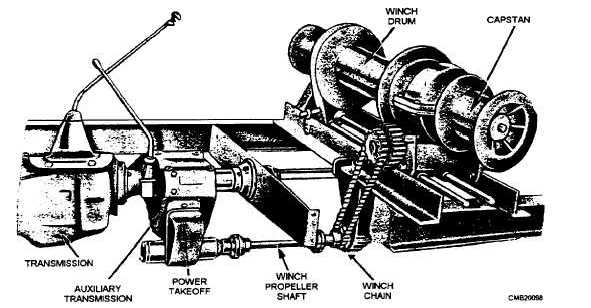Second Gear
To shift into second, the operator depresses the clutch and moves the shift lever into second gear. The second-third-speed synchronizer has been moved to the right so its internal teeth engage the external teeth of the main shaft second-speed gear. Power is transmitted by the countershaft second-speed gear to the main shaft second-speed gear, which is coupled to the main shaft by the second-third-gear synchronizer, and to the main shaft (fig. 4-20, view C). Gear ratio is approximately 4.18 to 1.
Third Gear
To shift into third, the operator depresses the clutch and moves the shift lever disengaging the second-third synchronizer from the main shaft second- speed gear. The second-third-speed synchronizer has been moved to the left so its internal teeth engage the external teeth of the main shaft third-speed gear. Power is transmitted by the countershaft third-speed gear to the main shaft third-speed gear, which is coupled to the main shaft by the second-third synchronizer and through the main shaft (fig. 4-20, view D). Gear ratio is approximately 2.45 to 1.
Fourth Gear
The operator depresses the clutch and moves the shift lever disengaging the second-third synchronizer from the main shaft third-speed gear. The fourth-fifth- speed synchronizer has been moved to the right so its internal teeth engage the external teeth of the main shaft fourth-speed gear. Power is transmitted by the countershaft fourth-speed gear through the main shaft fourth-speed gear, which is coupled to the main shaft by the fourth-fifth-speed synchronizer, and through the main shaft (fig. 4-20, view E). Gear ratio is approximately 1.45 to 1.
Fifth Gear
The operator depresses the clutch and moves the shift lever disengaging the fourth-fifth-speed synchronizer from the main shaft fourth-speed gear. The fourth-fifth-speed synchronizer is moved to the left so its internal teeth engage the external teeth of the input gear. Power is transmitted by the input gear, which is coupled to the main shaft by the fourth-fifth- speed synchronizer. Since the interlocking action of the synchronizer, in effect, makes one continuous shaft of the input shaft and the main shaft, the drive is direct (fig. 4-20, view F). Gear ratio is 1.00 to 1.
UXILIARY TRANSMISSIONS
The auxiliary transmission (fig. 4-21) is used to provide additional gear ratios in the power train. This transmission is installed behind the main transmission and power flows directly to it from the main transmission, when of the integral type, or by a short propeller shaft (jack shaft) and universal joints.

Figure 4-21. - Auxiliary transmission with power takeoff used for driving winch.
Continue Reading